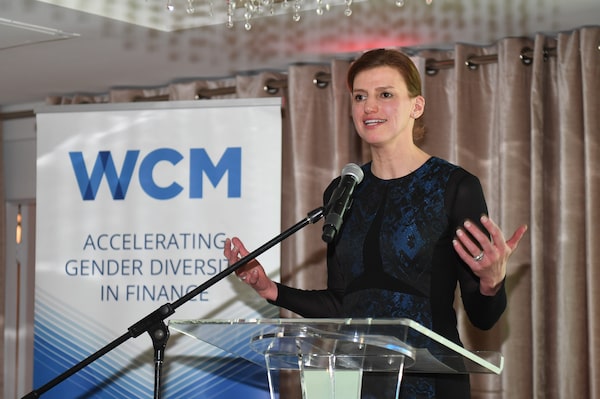
Camilla Sutton.Supplied
Camilla Sutton is President and CEO of Women in Capital Markets
I stepped into my role as president and CEO of Women in Capital Markets (WCM) three years ago in the midst of #MeToo, a watershed moment of recognition of the intertwined role of power with the widespread occurrences of sexual harassment and abuse. This past summer, the resurgence of Black Lives Matter (BLM) sparked widespread and long-overdue acknowledgment of systemic racism, inequities, the oppression of Black, Indigenous and people of colour (BIPOC) and the inexcusable abuse of power. These aha moments are important turning points, but they are also excruciatingly painful moments for those living within the marginalized communities.
Both of these movements demand radical change by holding power to account, spreading knowledge and pressing for immediate action. To achieve sustained diversity, corporate Canada needs to do the same.
Years of diversity initiatives have yet to yield lasting systemic change. In many ways, traditional diversity interventions have resulted in unintended and, at times regressive, effects, by reinforcing the status quo of whiteness and masculinity as the normative culture, and requiring employees outside this dominant group to “fit in” to succeed in their careers.
Consider how initiatives that target BIPOC or women subtly imply that they are inherently inadequate and signal that for them to advance, they require additional remedial training. Meanwhile, the dominant group does not need leadership skill-building to succeed. This approach places the onus on women and BIPOC to advance in a system that is rigged against them, and distracts from addressing the real issue: the structural barriers and inequities that put women and other non-dominant groups at a significant disadvantage.
To date, we’ve propped up our equity, diversity and inclusion initiatives with “the business case for diversity” – emphasizing the economic and competitive advantage diversity brings to organizations. We now have endless data proving the benefit of having diverse teams and yet, diverse teams are still few and far between.
Not only is the business case not working, it is a barrier to real progress. The fact that organizations need financial or business incentives to attempt to include women, BIPOC and other oppressed groups in our workplaces is alone indicative of the gravity and complexity of the problem.
When we drill down into the lived experiences of women in finance, they sit in stark contrast to the reported experiences of men. WCM’s recent survey of 600 professionals found only half of women believe they are treated equally and one-third believe they are paid equally to other genders. A third of women believe their firms are free from gender bias and that the promotion process is fair and objective. Finally, women remain twice as likely to perceive or experience harassment at work as men.
These results are frustrating to me and most of the leaders I speak to, particularly as they persist in an industry that is miles ahead of most when it comes to diversity.
What is needed is widespread acknowledgment of the systemic inequities that persist, and for those in the dominant group to recognize their significant power and privilege, which put them in a position to effect organizational change. The path toward systemic change begins with taking responsibility, acknowledging the inequities, becoming an ally and expanding one’s awareness and understanding of racial and gender equity. There are several leaders within finance that are doing exactly this and it is having impact, but we need more.
Then we need to shift the focus away from developing demographic-specific talent and onto building a more equitable system, one that has the distribution of opportunities, advancement practices and policies all working to address systemic barriers.
WCM’s latest report, The Equity Equation, provides a detailed road map toward equity, diversity and inclusion in the workplace. Our recommendations include:
Make and articulate a commitment to equity. This starts by acknowledging the systemic barriers that many employees face and how that radically changes how each individual experiences the same workplace.
Build equity, diversity and inclusion literacy across your firm. Unconscious bias training has done little to yield progress; however, building diversity literacy will. Start with the basics – what is the difference between equity and equality, what is race, what is systemic racism – and build from there. The goal is that all employees can easily recognize subtle and not-so subtle inequities and biases.
Fix and focus on the system, not the individuals. Ending systemic bias, sexism and racism requires the elimination of structural barriers and inequities. Focusing on the individuals feels good and gets noticed, but will never yield true change. Implementing policies and procedures that debias the system is what is required. This means ensuring equal pay, reinventing how feedback and reviews take place, radically changing the promotion and hiring process and redesigning how both formal and informal opportunities are allocated.
Implement targets for a set period of time. Until structural barriers are dismantled and an equitable system is established, the use of targets is an effective way to increase representation of underrepresented groups.
Eliminate harassment and discrimination. Review and strengthen your sexual harassment and anti-discrimination policies, and reporting mechanisms. Ensure they are clear, detailed and accessible.
Measure, monitor and report on progress. This requires excellent data and thoughtful reporting that presents the facts, not the handful of individual success stories.
Achieving corporate Canada’s diversity goals is in sight, but will require a radical rethinking of our approach if we are to succeed.
Your time is valuable. Have the Top Business Headlines newsletter conveniently delivered to your inbox in the morning or evening. Sign up today.